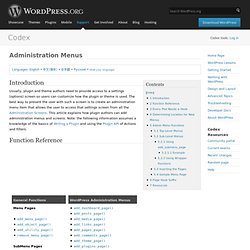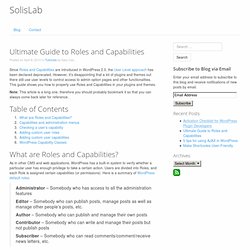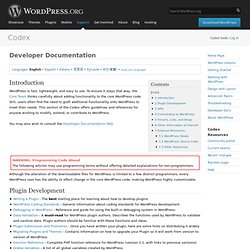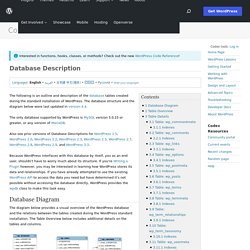

Administration Menus. Administration Menus Languages: English • 中文(简体) • 日本語 • Русский • (Add your language) Introduction Usually, plugin and theme authors need to provide access to a settings (options) screen so users can customize how the plugin or theme is used.

The best way to present the user with such a screen is to create an administration menu item that allows the user to access that settings screen from all the Administration Screens. This article explains how plugin authors can add administration menus and screens. Function Reference Every Plot Needs a Hook To add an administration menu, you must do three things: Create a function that contains the menu-building code Register the above function using the admin_menu action hook.
It is that second step that is often overlooked by new developers. Here is a very simple example of the three steps just described. <? In this example, the function my_plugin_menu() adds a new item to the Settings administration menu via the add_options_page() function. Dashboard. Roles and Capabilities. Roles and Capabilities Languages: English • Español • Français • 日本語 • Português do Brasil • 中文(简体) • (Add your language) Description WordPress uses a concept of Roles, designed to give the site owner the ability to control what users can and cannot do within the site.

A site owner can manage the user access to such tasks as writing and editing posts, creating Pages, defining links, creating categories, moderating comments, managing plugins, managing themes, and managing other users, by assigning a specific role to each of the users. WordPress has six pre-defined roles: Super Admin, Administrator, Editor, Author, Contributor and Subscriber.
The Super Admin role allows a user to perform all possible capabilities. Summary of Roles. Role Scoper. Ultimate Guide to Roles and Capabilities. Since Roles and Capabilities are introduced in WordPress 2.0, the User Level approach has been declared deprecated.

However, it’s disappointing that a lot of plugins and themes out there still use user levels to control access to admin option pages and other functionalities. This guide shows you how to properly use Roles and Capabilities in your plugins and themes. Note: This article is a long one, therefore you should probably bookmark it so that you can always come back later for reference. Table of Contents What are Roles and Capabilities? As in other CMS and web applications, WordPress has a built-in system to verify whether a particular user has enough privilege to take a certain action. This system of Roles and Capabilities is much more flexible than User Level, since it enables you to add, remove or reassign capabilities among roles. Capabilities and administration menus As you can see, there’s always a required parameter called capability for each of those functions. WP_Role Class. Members. Members is a plugin that extends your control over your blog.

It's a user, role, and content management plugin that was created to make WordPress a more powerful CMS. The foundation of the plugin is its extensive role and capability management system. This is the backbone of all the current features and planned future features. Adding default custom fields on new posts in WordPress. Developer Documentation. Developer Documentation Languages: English • Español • Italiano • 한국어 • Русский • 中文(繁體) • (Add your language) Introduction WordPress is fast, lightweight, and easy to use.

To ensure it stays that way, the Core Team thinks carefully about adding functionality to the core WordPress code. Still, users often find the need to graft additional functionality onto WordPress to meet their needs. You may also wish to consult the Developer Documentation FAQ. WARNING: Programming Code Ahead The following articles may use programming terms without offering detailed explanations for non-programmers.
Although the alteration of the downloadable files for WordPress is limited to a few distinct programmers, every WordPress user has the ability to effect change in the core WordPress code, making WordPress highly customizable. Plugin Development APIs Contributing to WordPress Forums, Lists, and Blogs Other Information of Interest External Resources. Function Reference. Languages: English • Español • فارسی • Français • Italiano • 日本語 ქართული • 한국어 • Português do Brasil • Русский • Türkçe • עברית • 中文(简体) • 中文(繁體) • (Add your language) The files of WordPress define many useful PHP functions.

Some of the functions, known as Template Tags, are defined especially for use in WordPress Themes. There are also some functions related to actions and filters (the Plugin API), which are therefore used primarily for developing Plugins. The rest are used to create the core WordPress functionality. Many of the core WordPress functions are useful to Plugin and Theme developers. You can help make this page more complete! Function history with occurrence and line number. Database Description. Languages: English • العربية • 日本語 中文(简体) • 한국어 • (Add your language) The following is an outline and description of the database tables created during the standard installation of WordPress.

The database structure and the diagram below were last updated in version 4.4. The only database supported by WordPress is MySQL version 5.0.15 or greater, or any version of MariaDB. Also see prior versions of Database Descriptions for WordPress 1.5, WordPress 2.0, WordPress 2.2, WordPress 2.3, WordPress 2.5, WordPress 2.7, WordPress 2.8, WordPress 2.9, and WordPress 3.3. Because WordPress interfaces with this database by itself, you as an end user, shouldn't have to worry much about its structure. Database Diagram The diagram below provides a visual overview of the WordPress database and the relations between the tables created during the WordPress standard installation. (WP 4.4.2 Database diagram) Table Overview Table Details Indexes Table: wp_links Table: wp_options Table: wp_posts Table: wp_terms Resources. WP3.0-ERD.png (PNG-Grafik, 1079x1089 Pixel) - Skaliert (66%)